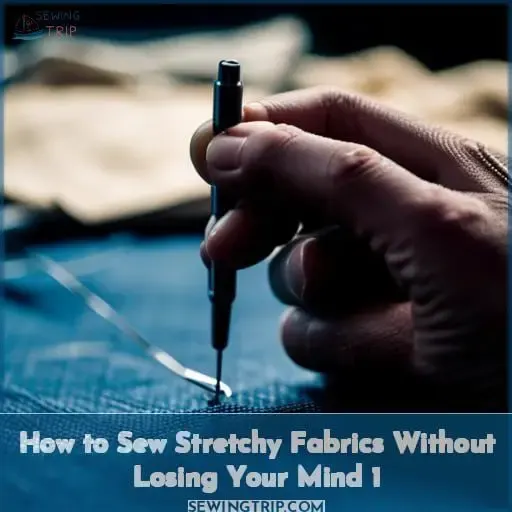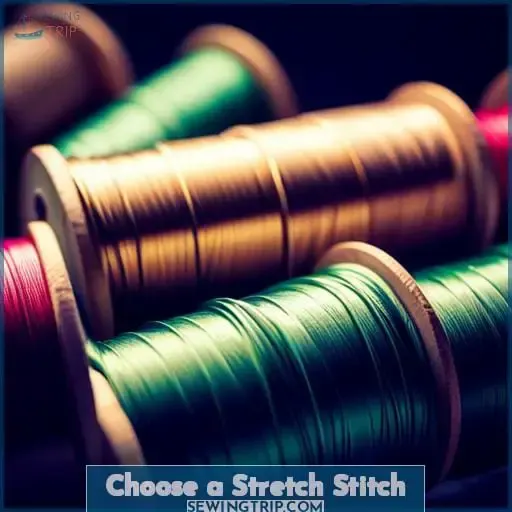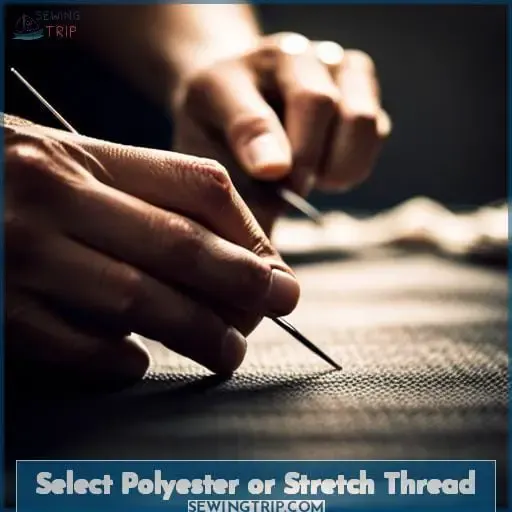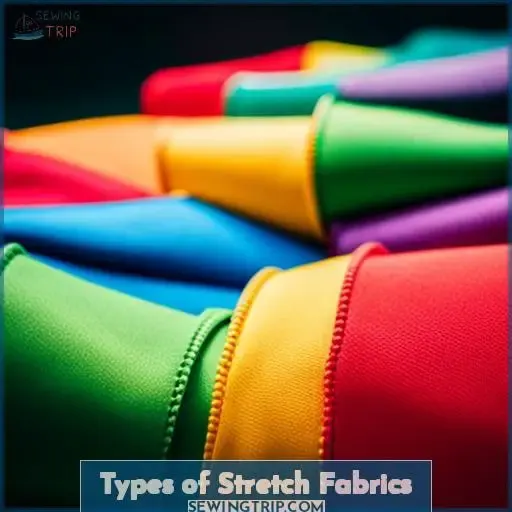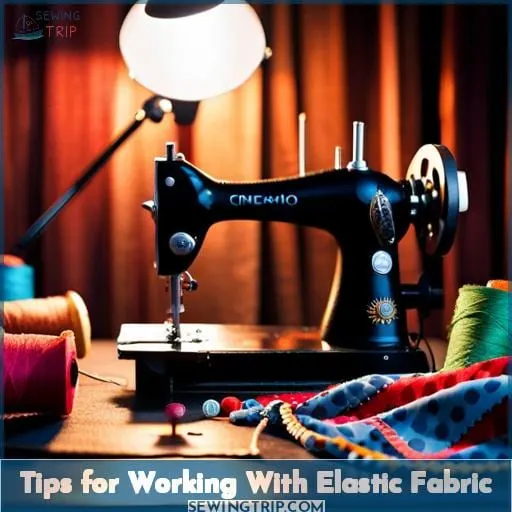This site is supported by our readers. We may earn a commission, at no cost to you, if you purchase through links.
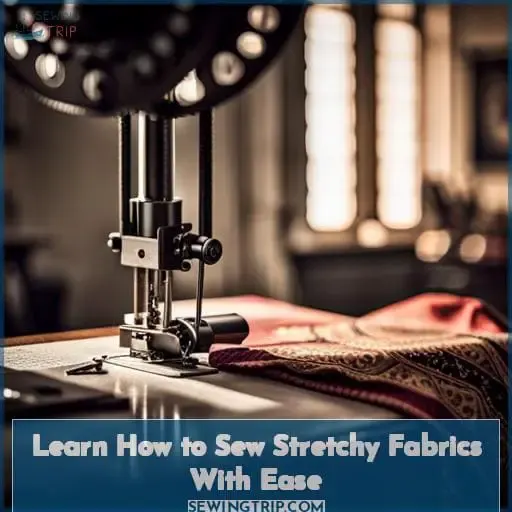 Are you a sewer looking to take your skills up a notch? Working with stretchy fabrics can be intimidating, but it doesn’t have to be. With the right tools and techniques, sewing stretchy fabrics without losing your mind is achievable! Learn how to sew these elastic materials with ease by following our simple steps.
Are you a sewer looking to take your skills up a notch? Working with stretchy fabrics can be intimidating, but it doesn’t have to be. With the right tools and techniques, sewing stretchy fabrics without losing your mind is achievable! Learn how to sew these elastic materials with ease by following our simple steps.
From using ballpoint needles and selecting polyester thread, all the way through stabilizing fabric types and working with elastic – we’ll cover everything you need for successful projects every time.
Table Of Contents
Key Takeaways
- Use a ballpoint needle for sewing stretchy fabrics.
- Choose a stretch stitch that matches the fabric’s stretch percentage.
- Use polyester or stretch thread for better tension and durability.
- Stabilize fabric with fusible tricot interfacing to prevent damage.
Use a Ballpoint Needle
Using a ballpoint needle is essential when sewing with stretchy fabrics. It’ll help you get the professional look you’re aiming for without stressing out! Opt for a stretch or twin needle instead of universal needles, as they can be too sharp and leave holes and runs in the fabric.
When securing your fabric pieces with pins, make sure they are also ballpoint to reduce the chances of damaging your material.
To achieve extra elasticity on hems, cuffs, collars, etc., try incorporating some type of stretch thread such as Maxi-Lock Stretch Thread or wooly nylon.
Stabilizing knit fabrics before stitching them together can be done by attaching interfacing like fusible tricot interfacing, which has great elasticity properties. Remember to press seams flat after stitching, rather than pulling them apart while pressing down ironing board coverings first.
Following these top tips will give beginners confidence when tackling their next project involving stretchy materials!
Choose a Stretch Stitch
Choose the right stretch stitch for your project and make sure it’s as tight a fit as slipping into a glove! When sewing with stretchy fabrics, consider the percentage of stretch in the fabric to ensure it matches up with any pattern you’re using.
It’s also important to check the alignment of the needle before starting so that you can create better-looking seams when working on knit fabric. Using dual feed foot or walking foot attachments while stitching will help prevent stretching of the material too.
To further stabilize materials like knitted fabrics, use interfacing or knit stay tape and press edges flat afterwards instead of pulling them apart. For extra elasticity on hems, cuffs, and collars, try incorporating some type of Maxi-Lock Stretch Thread or wooly nylon, which won’t break easily when used with these types of fabrics.
Use this guide for valuable information regarding how best to sew different types of 4-way jersey stretches without losing your mind along the way.
Select Polyester or Stretch Thread
Selecting the right thread for your stretchy fabric projects can take your look from frumpy to fabulous – so don’t skimp on this important step! Polyester thread is recommended over cotton as it won’t break too easily and will help maintain tension when stretching seams.
A special needle or presser foot may be required depending on the type of elastic fabrics you’re working with. For example, a ballpoint needle or walking foot can be used to avoid shifting fabrics while gathering fabric.
When using a standard sewing machine, opt for zigzag stitches instead of straight stitch if additional stretch tension is needed. Stretch twin needles are also an option for a more professional finish that prevents unwanted holes in the garment.
With these tips in mind and careful attention paid towards selecting polyester threads over cotton ones (which break too easily), liberating power and control await sewers who’ve conquered their fear of stretchy fabrics!
Stabilize Your Fabric
Stabilize your fabric and take control of stretchy fabrics with the help of fusible tricot interfacing.
To start, understand Interfacing Basics. When sewing knit fabrics like cotton jersey, it’s best to stabilize them with an iron-on woven or nonwoven fusible.
Additionally, Curl Prevention is key. Use starch spray on edges before pressing or opt for a dual feed foot attachment on the machine.
When creating buttonholes in elastic materials, be sure to sew along the direction of least stretch.
Triple stitch settings are also great for added strength. However, avoid using lightning bolt stitches since these can cause puckering.
Finally, wooly nylon thread works well when applying topstitching details. This thread has some give that helps maintain tension without breaking too easily!
Types of Stretch Fabrics
Understanding the different types of stretch fabrics, like knitted, woven, and bias-cut pieces, will give you confidence to create comfortable garments that fit your body perfectly! Stretchy properties vary among materials.
Jersey fabric is a type of knit fabric with elasticity levels between 10% and 25%. It has 4-way stretch, allowing for more freedom when wearing it. Double knits are another type of jersey fabric that offers additional support but also has less flexibility than single jerseys.
Bias-cut pieces can be used to create an even greater degree of movement in clothing designs as they increase elasticity due to their diagonal weave pattern.
Other forms include spandex/lycra blends or elastane fibers, which provide excellent shape retention while remaining breathable at the same time. Elastic fabrics like these require special techniques for proper construction, such as using a walking foot attachment on your machine or opting for longer stitch length settings if available on your machine when sewing seams together with a straight stitch setting.
Regardless of what kind of stretchy fabric you choose, taking some extra precautions during preparation before beginning any project should help ensure success along the way towards creating beautiful clothes tailored specifically according to one’s own needs and wants without compromising quality or style!
Tips for Working With Elastic Fabric
Now that you understand the different types of stretch fabrics, it’s time to get down to the nitty-gritty and talk about sewing with them.
- Press edges before cutting fabric – this will help reduce curl from happening when you sew it.
- Use a dual feed foot or walking foot attachment on your machine to prevent stretching of fabric when stitching seams together.
- To keep knit fabrics flat while sewing, use a starchy spray and press often as needed during the construction process.
- When stitching buttonholes in stretch fabric, be sure to stitch in the direction of the least amount of stretch for the best results. Also, stabilize the wrong side by fusing fusible interfacing prior if necessary.
- Consider the percentage of stretch found within chosen pattern pieces so they match better against the actual material used – this is key! It’s important not only to check alignment but also to take extra time while piecing sections together since there can be too much tension between two layers that don’t complement each other well enough depending on how tight the seam allowance was originally set up at the beginning stages (i.
Frequently Asked Questions (FAQs)
What type of needle is best for sewing stretchy fabrics?
A ballpoint needle or stretch needle is best for sewing stretchy fabrics. Universal needles are too sharp and can cause damage, while a twin-needle stitch will give a professional look.
What type of thread should be used when sewing stretchy fabrics?
When sewing stretchy fabrics, use polyester or special stretch thread for a professional look and to prevent seam breakage. Maxi-Lock Stretch Thread and wooly nylon are good options for added durability. Invest in the right tools – including needles, pins, and stitches – to ensure top-notch results.
How can I prevent fabric from stretching when sewing stretchy fabrics?
To prevent stretching, use a walking foot attachment and a dual feed foot to hold the fabric in place. Choose the right needle for your project – ballpoint or stretch needles are best. Stabilize with interfacing or knit stay tape and opt for polyester thread over cotton.
What are the different types of stretch fabrics available?
Stretch fabrics come in many varieties, such as knitted, woven, and bias-cut. Jersey has four-way stretch, while some heavier fabrics have two-way.
What tips do you have for working with elastic fabrics?
For elastic fabrics, use a ballpoint needle or stretch needle to prevent damage. Use zigzag or other stretch stitches instead of a straight stitch and polyester thread for added strength. Stabilize the fabric with interfacing or knit stay tape and consider using a dual feed foot attachment when stitching buttonholes.
Conclusion
You can now go forth and sew stretchy fabrics with confidence!
You now know that you need a ballpoint needle, the right type of thread, and the right kind of stitch for your fabric.
You know the types of stretch fabrics and the tips to help you work with them.
You can even go the extra mile with stabilizers and interfacing.
You can do a fantastic job, even if the fabric is a little intimidating.
With the right knowledge and a few helpful tips, you can create amazing garments with stretch fabrics that will look professional and be comfortable.
So, go ahead and get creative with your stretchy fabrics!

